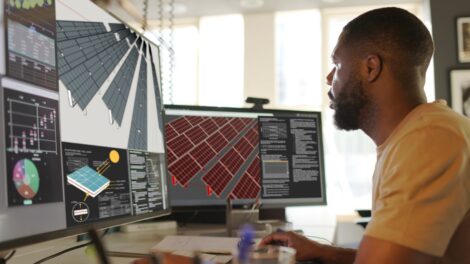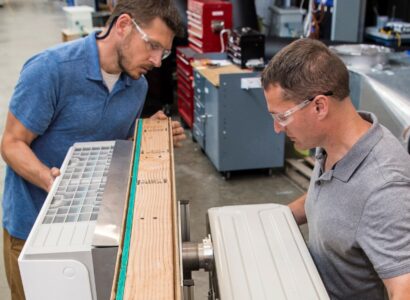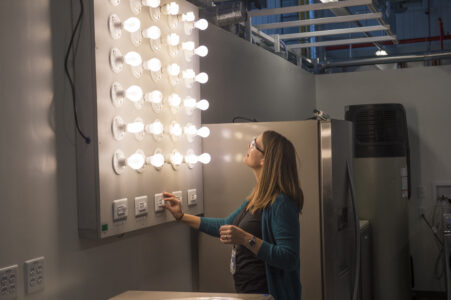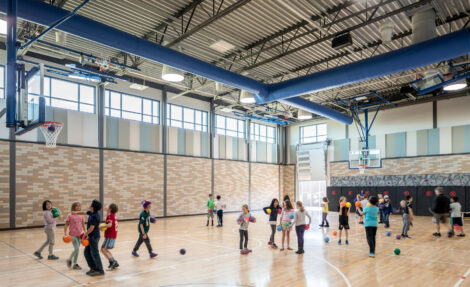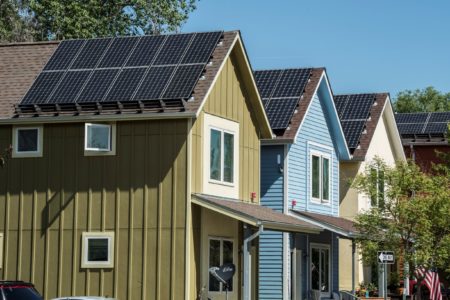That’s a Wrap!
Note that this challenge was for the Fall 2023 competition.
The objective of this challenge is to improve the building envelope performance of new or existing residential buildings by reducing energy consumption in a cost-effective and accessible way.
Background
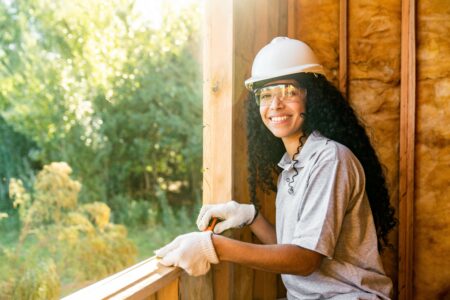
Source: GettyImages
In the heat of summer, does your air conditioner seem to run all the time? In winter, do cold drafts in your house make it impossible to get comfortable? Your house may be energy inefficient due to the performance of the building envelope. The building envelope—consisting of the walls, roof, foundation, and windows—separates the interior living conditions from the exterior weather and is the single largest contributor to primary energy use in residential buildings.1 Nearly 60% of total residential building energy is used to provide occupant comfort by heating, cooling, and ventilating the living space.2 The performance of the building envelope disproportionally affects communities that lack the resources to improve the quality of the building envelope through remediation techniques.3
One of the primary functions of the building envelope is to control the flow of matter and energy—specifically, the flow of moisture, air, and heat between the interior and exterior.4 Failure to control this flow can cause reductions in energy efficiency, durability issues, decrease in occupant comfort, and reduced indoor air quality, which can lead to mold and cause significant health issues.5 The flow of moisture (both liquid water and vapor) is typically controlled using water-resistive barriers, ventilation air gaps, and drainage planes. The flow of air is typically controlled using air-resistive barriers and air sealing techniques. The flow of heat is controlled using insulation and solar reflectance. While new building construction can easily benefit from novel technologies and methods, many of these control methods can be difficult, cost-inhibitive, or sometimes even impossible to implement into existing buildings.6
More than 50% of existing residential buildings in the United States were built before 1980 when energy conservation codes were first introduced,7 and they lack modern efficient technologies that effectively control the flow of matter and energy. However, less than 2% of U.S. buildings are remediated each year8 to improve the energy efficiency, primarily because the cost to retrofit commonly exceeds several thousand dollars9 and often falls entirely on the building owner. In some cases, the building owner may have a high energy burden and may not have the resources to improve the quality of the building envelope to lower energy consumption. Energy burden is the percentage of a household’s gross annual income spent on energy costs (including electricity, natural gas, and other home-heating fuels).10 A person is considered energy burdened if they spend 6% or more of their annual income on energy costs.11 Lower income households are disproportionally impacted by energy burden—households that make $15,000 or less per year spent on average 21% of their income on utilities and may forgo other life necessities in order to address issues with the envelope.12 To increase energy efficiency and address energy burden, innovative solutions must be developed that provide access to energy-efficient, cost-effective, and accessible building envelopes.
Common remediation strategies to improve the building envelope performance of existing buildings require that occupants leave their homes for days or weeks while the envelope is tested, sealed, or rebuilt. For some individuals and families, temporary relocation is often not a possibility due to limited resources; remediation strategies are often delayed, sometimes indefinitely.
Remediation techniques to improve the quality and performance of the building envelope vary in effectiveness, affordability, and accessibility. To evaluate and remediate air leakage issues, a blower door test is often used to pressurize the building and search for air leaks,13 which is time consuming and requires specialized equipment. Sealing of air leaks is commonly performed manually using sealant. Innovative solutions are required to improve both the process of finding and sealing air leakage. When an envelope is made more airtight, the susceptibility to moisture damage increases14; therefore, remediation efforts should be accompanied by analysis or evaluation to predict if moisture durability will be a concern. Moisture durability prediction tools commonly require expert input or destructive methods. Innovative solutions are needed to make the moisture durability assessment process more affordable, more accessible, and widely available. To improve thermal performance of the envelope, insulation or solar reflectivity is added to the walls, roof, or foundation. Additionally, windows can be replaced with more thermally efficient modern designs. Some insulation remediation strategies exist that allow occupants to stay within their homes while the envelope performance is improved15; however, these solutions are often not cost-effective, not applicable to all types of existing construction, or not widely available on the market in the United States. Innovative solutions are needed to generally improve the affordability, accessibility, and quality of building envelope remediation strategies.
The Challenge
This challenge asks student teams to address the high energy burden that some communities face by developing an innovative solution that allows building owners to access high-quality and affordable envelope remediation or construction technologies, strategies, or methods. Students may consider solutions to address air leakage, moisture durability, and/or thermal performance of the envelope for new or existing residential buildings. Students must target solutions that are cost-effective, affordable, quickly implemented, and accessible to the end user.
Suggestions for the student teams include (but are not limited to) developing cost-effective, fast, and accessible solutions or technologies to:
- Detect and seal air leakage through the building envelope.
- Predict, assess, or evaluate the moisture performance or potential moisture damage of the building envelope.
- Add insulation, air barriers, water barriers, and/or weather resistance (cladding) to existing building envelope elements—walls, roof, foundation, etc. Students should target solutions that are directly applicable to housing types that may need the most improvement, such as low-median-income manufactured housing or large multifamily housing.
- Increase the function of the building envelope to limit the flow of air, water, and/or heat for new residential buildings. Students should target solutions that are directly applicable to low-median-income housing such as manufactured housing or large multifamily housing.
- Increase accessibility of specific, deployable envelope retrofit technologies by using existing rebate programs. Students should focus on using existing rebate or incentive programs at the federal, state, county, or city levels to increase the adoption of specific, deployable technologies or remediation strategies.
- Increase accessibility of specific, deployable envelope retrofit technologies, and develop education programs to accelerate deployment.
- Harness ambient energy from the sun, air, or sky to make the building more energy efficient.
Student submissions should:
- Describe the scope and context of the problem based on a current or emergent problem(s) in the United States.
- Identify affected communities, making sure to research stakeholder backgrounds and understand the stakeholders’ needs.
- Develop a novel technical solution to address the problem at the building scale; the solution can include technical and/or nontechnical aspects such as policy or economic solutions and may focus on new or existing residential buildings.
- Discuss appropriate and expected impacts (including any unintended consequences) and benefits of the proposed solution; include a cost analysis of the proposed solution.
- Develop a plan that describes how the team envisions bringing its idea from concept to implementation, such as a technology-to-market plan for a commercially viable, market-ready product for real buildings, and/or integration into the planning and design process.
Downloadable Challenge Description
Additional Challenge Resources
Submission Template
Requirements
Competing in this challenge is open to student teams currently enrolled in U.S. universities and colleges. See the Terms and Conditions and Rules document for eligibility requirements and rules. Please note that you must begin your Building Technologies Internship Program (BTIP) application before or at the same time as you submit your idea in order to compete in the JUMP competition.
Please submit the following as a single-spaced PDF document that is a written narrative of the team’s proposed solution. PowerPoint decks or submissions in presentation format do not meet the requirement. Plagiarism will not be tolerated. The quality of writing will be considered, so review by peers is strongly encouraged.
- Project Team Background (up to 2 pages, single-spaced)
- Form a team of 2‒4 students. These students represent the project team and will all consult on the problem.
- The Project Team Background should include:
- Project name, team name, and collegiate institution(s)
- Team mission statement
- A short biography for each team member. This should include information such as major, level (freshman, sophomore, junior, senior, graduate), and other relevant background information such as experience with building science, future career goals, and formative experiences that shaped each individual’s contribution to the Challenge.
- Diversity statement (minimum 1 paragraph, 5‒7 sentences): One of JUMP into STEM’s key objectives is to encourage diversity of thought and background in students entering the building science industry. There is a diversity gap in STEM, meaning that certain groups are underrepresented or have been historically excluded from STEM fields. These groups include, but are not limited to, those based on race, ethnicity, and gender—and this gap needs to be addressed. Diversity of thought can be achieved through teams consisting of students from different majors and minors. If there are barriers that affect the racial, ethnic, and/or gender breakdown of your team, please elaborate. The diversity statement is your opportunity to describe your team’s diversity of background and thought, both generally and as applicable to your chosen Challenge.
- The Project Team Background does not count toward the 5-page Project Challenge Submission.
- Project Challenge Submission (up to 5 pages, single-spaced)
- Select one of the three Challenges published for the current competition to address.
- Investigate the background of the Challenge and consider related stakeholders. Stakeholders are those who are affected by the problem, a part of the supply chain, or manufacturing of the technology product(s), as well as those who may have decision-making power and are able to provide solutions (technical or nontechnical solutions, such as policies). For example, you could include stakeholders who have previously experienced environmental pollution or a high energy burden.
- Write a 1- to 2-paragraph problem statement, focusing on a specific aspect of the problem and the stakeholder groups affected by or involved in the problem. The stakeholder groups can be from a specific location, socioeconomic status, age, or demographic (e.g., people living in subsidized housing).
- Develop and describe a novel solution that addresses or solves the specific problem from your problem statement. The solution must be technical and also include one or more of the following components, as appropriate: economic, policy, commercialization, codes, standards, and/or other.
- Address the requirements for your selected Challenge as written in the Challenge description. Include graphs, figures, and/or photos. Discuss the feasibility of your solution and how it will impact your stakeholders,
- Develop a technology-to-market plan. A technology-to-market plan describes how the team envisions bringing its idea from concept to installation on real buildings, or integrated into the design of real buildings, and includes a cost/benefit analysis.
- The cost/benefit analysis does not need to be exhaustive and should include comparing the solution to current or existing technologies or practices. Benefits, such as building energy reductions and improved occupant health or productivity, should be evaluated.
- The plan should also discuss which key stakeholder(s) should be involved to commercialize the technology and then sell and install the technologies with your target market(s).
- Perform a market adoption barrier analysis. The team should identify at least one key market adoption barrier for implementation and specifically address how the proposed solution will overcome that barrier.
- Barriers should align with key stakeholder(s) identified by the student team.
- Include references. References will not count toward the 5-page maximum.
- Appendix (optional, no page limit)
- Teams may wish to add an appendix. This is optional and might not be reviewed by the judges.
- The appendix has no page limit.
Evaluation Criteria
Solution (40%)
- Solution: Please rate the solution and its ability to address the problem statement. The solution must be a technical solution. It should address the stakeholder needs. It must include one or more of the following components, as appropriate: economic, policy, commercialization, codes, standards, or other.
- Feasibility: Please rate the solution’s overall feasibility. For example, solutions that are not technically possible or that lack a technical feasibility discussion will receive lower scores.
- Novelty: Please rate the originality and creativity of the solution and how significant the contribution will be to the building industry.
- Impact: Please rate the overall scalability of the team’s solution. For example, can the solution be extended to communities, similar stakeholder groups, or a nationwide solution?
Market Readiness (30%)
- Market Characterization: Please rate the team’s description and understanding of the market.
- Technology-to-Market: Please rate the team’s proposed plan to bring the solution from a paper concept to installation or integration with real buildings or building designs, and the team’s cost/benefit analysis. The cost/benefit analysis may include energy reductions or benefits to occupant health and productivity.
- Overcoming Adoption Barriers: Please rate the team’s identification of and plan for overcoming at least one key market adoption barrier for the proposed solution. This includes how the solution will create value, both economic and other, to drive industry adoption.
Team Diversity and Understanding Stakeholders (20%)
- Diversity Statement and Project Team Background: Please rate how well the team addresses the diversity gap in the building science industry in its diversity statement. This includes how the team brings perspectives from a variety of backgrounds, including students from groups that are underrepresented in science, technology, engineering, and math (STEM). This also includes students from many different disciplines ensuring diversity of thought. See the diversity statement in the challenge requirements. This also includes how well the teams connect their mission statement and biographies to their problem statement.
- Understanding Stakeholders: Please rate how well the team communicates their understanding of the stakeholder group or community and how they are affected by the problem. This rating also includes how well the team defined the problem that needs to be solved by taking into consideration the needs of the stakeholder group or community.
Submission (10%)
- Submission Requirements: Please rate how well the student team followed all submission requirements. See the submission requirements at the bottom of each challenge description.
How to Create a Successful Submission
We will have two student webinars.
Student Webinar #1
Student Webinar #2
Citations
- Harris, C. 2021. Opaque Envelopes: Pathway to Building Energy Efficiency and Demand Flexibility: Key to a Low-Carbon, Sustainable Future. U.S. Department of Energy. DOE/GO-102021-5585. https://doi.org/10.2172/1821413
- S. Energy Information Administration. 2022. Annual Energy Outlook 2022. Washington, D.C. https://www.eia.gov/outlooks/aeo/.
- S. Department of Energy. 2022. Disadvantaged Communities Reporter from DOE: Office of Economic Impact and Diversity (Justice40). https://energyjustice.egs.anl.gov/
- Straube, J.F. and Burnett, E.F.P. 2005. Building Science for Building Enclosures. Westford, MA: Building Science Press Inc.
- Weinhold, B. 2007. A Spreading Concern: Inhalational Health Effects of Mold. Environmental Health Perspectives, 115(6), A300–A305. https://doi.org/10.1289/ehp.115-a300
- S. Department of Energy. 2014. Windows and Building Envelope Research and Development: Roadmap for Emerging Technologies. DOE/EE-0956. Washington, D.C. https://www.energy.gov/eere/buildings/downloads/research-and-development-roadmap-windows-and-building-envelope.
- S. Energy Information Administration. 2020. Residential Energy Consumption Survey. Washington, D.C. https://www.eia.gov/consumption/residential/data/2020/
- Olgyay, V. and Seruto, C. 2010. Whole Building Retrofits: A Gateway to Climate Stabilization. Rocky Mountain Institute. https://rmi.org/insight/whole-building-retrofits-a-gateway-to-climate-stabilization/
- S. Census Bureau. 2019. American Housing Survey: Home Improvement Costs – Owner-Occupied Units. https://www.census.gov/programs-surveys/ahs.html
- Lewis, J., Hernández, D. and Geronimus, A.T. 2020. Energy efficiency as energy justice: addressing racial inequities through investments in people and places. Energy Efficiency 13, 419–432. https://doi.org/10.1007/s12053-019-09820-z.
- Fisher Sheehan & Colton. 2020. Home Energy Affordability Gap. Fisher, Sheehan & Colton. http://www.homeenergyaffordabilitygap.com/index.html.
- Carliner, M. 2013. Reducing Energy Costs in Rental Housing: The Need and the Potential. Research Brief. Joint Center for Housing Studies of Harvard University. https://www.jchs.harvard.edu/sites/default/files/carliner_research_brief_0.pdf.
- ASTM Standard E1827. 2017. Standard Test Methods for Determining Airtightness of Buildings Using an Orifice Blower Door. ASTM International, West Conshohocken, PA. https://www.astm.org/e1827-11r17.html
- S. Department of Energy. 2015. Building America Research-to-Market Plan. https://www.energy.gov/sites/prod/files/2015/11/f27/Building%20America%20Research%20to%20Market%20Plan-111715.pdf.
- Neuhauser, K. 2013. Evaluation of Two CEDA Weatherization Pilot Implementations of an Exterior Insulation and Over-Clad Retrofit Strategy for Residential Masonry Buildings in Chicago. Building Science Corporation for the U.S. Department of Energy. https://www.nrel.gov/docs/fy13osti/57989.pdf
